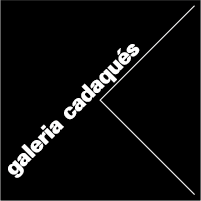
galeria cadaqués – huc malla reopens the doors of the emblematic gallery cadaqués 2 inviting gorka chillida and the curator irene altaió, who has proposed a dialogue between the work of the artist from donostia gorka chillida with works by artists of reference in concrete art (max bill, richard paul lohse, max hubert, among others). the exhibition by gorka chillida (donosti, 1981), entitled hacer crecer (making grow), brings together a group of eighteen steel sculptures in various formats and more than forty recent drawings. son and grandson of a saga of internationally renowned Basque artists, gorka chillida has recently begun to show his work, with an exceptional reception in madrid, donosti, barcelona and now in cadaqués. is the author of the poster drawing for the current edition of the Cadaqués music festival, where he outlines the perimeter of the bay of Cadaqués with the geometric shapes so characteristic of his drawing. his work explores the volumetric potential of space. the sculptures originate from small steel tubes, the ends of which expand to generate layers, cavities and openings that gravitate over their own bodies. when creating them, gorka chillida leaves the texture of the welds that join the small pieces together visible on his skin, thus provoking a visible play of contrasts. is an exercise that develops the balance between the dualities of inside and outside, of visible and hidden, suspension and gravity. la obra pide al espectador una actitud activa a fin de encontrar desde el punto de vista, siempre cambiante, un camino dentro de las cavidades por donde orientar la mirada y el pensamiento. In the case of drawing, he follows the explorations begun in sculpture, and starting from the void, he constructs a fabric of forms with a marked geometric character, which constitute “colonies” created with repetitive rhythms and variations. With a strong visual impact, in monochrome, his drawings are rigorous formal variations that grow organically.
gorka chillida’s exhibition is related to an exhibition of concrete art, one of the exhibition lines of the Italian-Swiss gallery owner, architect and artist lanfranco bombelli, founder of galeria cadaqués (1973-1997, reopened in 2003 by huc malla). thus, twenty years after the closure of the historic space galeria cadaqués 2 (1976-1982), which arose from the need to host a greater number of artists, some of them as important as joseph beuys, joan brossa, adolfo estrada, richard hamilton, david hockney, frank stella and mies van der rohe, this summer pays homage to concrete art, coinciding with the centenary of the bauhaus. the constellation of artists linked to the biography of lanfranco bombelli establishes a historical and conceptual framework akin to geometric, rigorous and systematic compositions based on minimal plastic means, which in the case of concrete art finds its inspiration in mathematics as well as gorka chillida in abstract compositions that grow organically. galeria cadaqués carried out a very important and legendary task as a publisher of graphic and multiple works, some of which are shown in this exhibition, either in process or in series. two works can be seen, beautifully coloured rhythms (1977) by max huber, an artist and graphic artist of Swiss origin and a protagonist of post-war constructive typography; an avant la lettre by max bill, vier mal drei gleiche farbquanten (1990), an edition for the poster of the Cadaqués music festival, and an exceptional edition from 1943. also on view are artist’s proofs and prints by richard paul lohse, dario grossi and heijō hang, from the cadaqués portfolio one (1973), edited by bombelli, which was the founding event of galeria cadaqués. jakob bill’s integrated silkscreen in cadaqués portfolio four (1997), in memory of his father max bill, is presented. by françois morellet is an exceptional edition of a post-Bauhaus drawing made with the programmed chance system (1997) and diagonale fragmentée (1978), a piece of contemporary jewellery in stainless steel. by sol lewittt, the strikingly beautiful woodcut on Japanese paper a form driven from a rectangular solid (1992). by the artist antonio calderara, two serigraphs, in large and small format, from the series of chromatic variations (1977). by adolfo estrada, the only representative of concrete art in spain, is presented as a frieze, a p/a of the cassia ensemble (1975). finally, paying explicit homage to lanfranco bombelli, who as a young man had collaborated in the revival of concrete art in the years immediately after the end of the second world war, three of his graphic works in black and white are set against the work of the also young artist gorka chillida.









